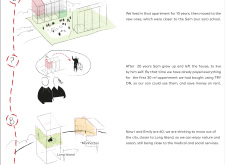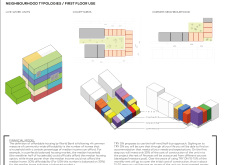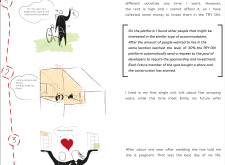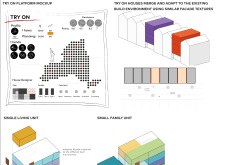5 key facts about this project
### Overview
Located in the urban context of New York City, the project addresses the complexities of modern housing by introducing a customizable living model. It aims to meet the evolving needs of individuals and families by providing adaptable spaces that reflect a shift from conventional static living arrangements to dynamic, personalized solutions. The initiative emphasizes financial accessibility through a hybrid ownership model, enabling gradual investment in homes while promoting community engagement and collaboration among residents.
### Spatial Configuration and User Experience
The design employs a modular approach, allowing flexibility in the spatial arrangements. Key features include:
- **Multi-Functional Living and Working Spaces:** Designed to accommodate both residential and small business needs, these units integrate work and living areas to enhance the day-to-day experience of users.
- **Shared Courtyards:** These communal spaces serve as focal points for social interaction, fostering community ties and enhancing the living environment.
- **Strategically Designed Neighborhoods:** The layout encourages interactions between residential and commercial elements, improving accessibility and integration within the urban fabric.
Attention to outdoor spaces is reflected in the inclusion of parks and communal areas, which contribute to the well-being of residents.
### Material Selection and Sustainability
The project places a strong emphasis on sustainable practices through its material choices, which include:
- **Recycled Materials:** Utilizing materials that minimize environmental impact ensures the construction adheres to eco-friendly standards.
- **Modular Brick Systems:** These systems facilitate easy reconfiguration of living units, supporting adaptability to various housing needs.
- **Integrated Renewable Energy Solutions:** Photovoltaic systems contribute to energy sustainability.
- **Water-Efficient Fixtures:** Low-flow systems are incorporated to promote conservation.
- **Sustainable Insulation:** The selection of insulation materials enhances energy efficiency across different climates.
These choices not only support a commitment to sustainability but also encourage innovation in construction methodologies.
### Financial Accessibility and Community Engagement
The financial model is structured around shared equity, allowing for a lower initial investment, thus encouraging participation from a broader demographic. This model ensures economic considerations do not dictate resident choices, fostering a diverse community.
Furthermore, a digital platform enables residents to articulate their housing needs, facilitating a crowd-sourced design process that enhances alignment with community aspirations. This approach underlines the project's commitment to merging physical and social housing needs while allowing for personal and communal growth within the urban setting.






















































